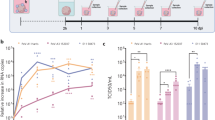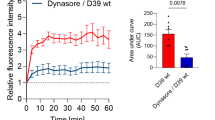Abstract
SUBACUTE sclerosing panencephalitis (SSPE), a progressive neurological disease of children, is characterized by intracytoplasmic and intranuclear inclusions in the neurones and glial cells. Although no infectious agent was isolated directly from the diseased brain tissue, a paramyxovirus, related serologically to the measles–rinderpest virus group, was recovered from SSPE brain cells maintained in tissue culture in serial passages1. These cultures were characterized by the formation of syncytia and by their capacity to undergo transformation2. Only by fusion with African green monkey kidney cells (AGMK) could an infectious syncytiogenic paramyxovirus be recovered from the brain cells.
This is a preview of subscription content, access via your institution
Access options
Subscribe to this journal
Receive 51 print issues and online access
$199.00 per year
only $3.90 per issue
Buy this article
- Purchase on Springer Link
- Instant access to full article PDF
Prices may be subject to local taxes which are calculated during checkout
Similar content being viewed by others
References
Barbanti-Brodano, G., et al., Proc. Soc. Exp. Med. (in the press).
Katz, M., Koprowski, H., and Moorhead, P., Exp. Cell Res., 57, 149 (1969).
Katz, M., Oyanagi, S., and Koprowski, H., Nature, 222, 888 (1969).
Hirt, B., J. Mol. Biol., 26, 365 (1967).
Katz, M., Rorke, L. B., Masland, W. S., Barbanti-Brodano, G., and Koprowski, H., J. Infect. Dis. (in the press).
Koprowski, H., Jensen, F. C., and Steplewski, Z., Proc. US Nat. Acad. Sci., 58, 127 (1967).
Gibbs, F. A., Gibbs, E. L., Carpenter, P. R., and Spies, H. W., J. Amer. Med. Ass., 171, 1050 (1959).
Richardson, jun., E. P., New Engl. J. Med., 265, 815 (1961).
Zu Rhein, G. M., in Progress in Medical Virology (edit. by Melnick, J. L.), 11, 185 (Karger, Basel, 1969).
Koprowski, H., Ponten, J. A., Jensen, F., Ravdin, R. G., Moorhead, P., and Saksela, E., J. Cell. Comp. Physiol., 59, 281 (1962).
Author information
Authors and Affiliations
Rights and permissions
About this article
Cite this article
KOPROWSKI, H., BARBANTI-BRODANO, G. & KATZ, M. Interaction between Papova-like Virus and Paramyxovirus in Human Brain Cells: a Hypothesis. Nature 225, 1045–1047 (1970). https://doi.org/10.1038/2251045a0
Received:
Revised:
Issue Date:
DOI: https://doi.org/10.1038/2251045a0
This article is cited by
-
Unusual features in a Case Diagnosed as Subacute Sclerosing Panencephalitis (SSPE)
Journal of Neurology (1979)
-
Ätiopathogenetische und therapeutische Aspekte der subakuten sklerosierenden Encephalitis
Archiv für Psychiatrie und Nervenkrankheiten (1975)
Comments
By submitting a comment you agree to abide by our Terms and Community Guidelines. If you find something abusive or that does not comply with our terms or guidelines please flag it as inappropriate.



